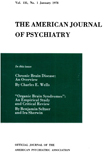MURDER WITHOUT APPARENT MOTIVE: A STUDY IN PERSONALITY DISORGANIZATION
Abstract
In this paper we have described a number of common characteristics found in individuals who have committed impulsive senseless murders. These characteristics were: severe weakness of impulse control; blurring of the boundaries between fantasy and reality, with periods of altered states of consciousness; blunted and shallow emotional reactions; and a violent and primitive fantasy life.
This constellation seems to have grown out of a history characterized by extreme parental violence and early severe emotional deprivation. In these cases, there appeared an ego weakness which allowed the periodic breakthrough of intense aggressive impulses, sometimes of homicidal proportion.
When such apparently senseless murders occur, they are seen to be an end result of a period of increasing tension and disorganization in the murderer starting before the contact with the victim who, by fitting into the unconscious conflicts of the murderer, unwittingly serves to set into motion his homicidal potential.
It remains a task of future research to: 1. Differentiate these individuals from other murderers as well as from others with similar disturbances but who do not kill; 2. Weigh the significance of the individual factors described; 3. Devise measures for identifying and effectively controlling these individuals before they commit murder.
Access content
To read the fulltext, please use one of the options below to sign in or purchase access.- Personal login
- Institutional Login
- Sign in via OpenAthens
- Register for access
-
Please login/register if you wish to pair your device and check access availability.
Not a subscriber?
PsychiatryOnline subscription options offer access to the DSM-5 library, books, journals, CME, and patient resources. This all-in-one virtual library provides psychiatrists and mental health professionals with key resources for diagnosis, treatment, research, and professional development.
Need more help? PsychiatryOnline Customer Service may be reached by emailing [email protected] or by calling 800-368-5777 (in the U.S.) or 703-907-7322 (outside the U.S.).



